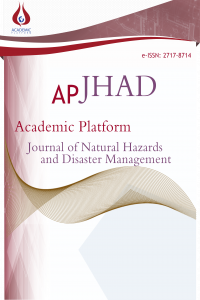What Damages Are the Most Frequent in Airport Infrastructure ?
Anahtar Kelimeler:
Airport infrastructure, Damages, Statistical analysis, Cracking
What Damages Are the Most Frequent in Airport Infrastructure ?
Airport is one of the most important infrastructure that have exhibited substantial growth and profits in recent years. Although airport infrastructure represents an important part in the economy of cities, researches have shown that many incidents that have led to flight disruptions have often occurred in airport infrastructure. Also, maintenance cost of airport buildings has increased significantly necessitating a call from professionals to investigate efficient methods of curbing the same. Hence, cost reduction is possible by innovating methods thanks to predictive maintenance techniques, which are based on artificial intelligence. However, working on the innovation of techniques that modernize maintenance in airport buildings is very hard due to the many types of cause incidents that exist. In fact, incidents can be caused due to different reasons (Structural, Electrical, Hydraulic, Computing, Unknown, etc.) This paper tackles this challenge by investigating and identifying the most frequent damages and their origins in airport infrastructure. The result showed that cracks are the most frequent type of damages and that wear is the most frequent origin of incidents in airport infrastructure. Also, it shows that 85,51% of cracks are located in runways. These findings help in better understanding the problem and serve as the point of departure for researchers who are interested in solving it.
Keywords:
Airport infrastructure, Damages, Statistical analysis, Cracking,
___
- Burbidge, R. (2016). Adapting European Airports to a Changing Climate. Transportation Research Procedia, 14, 14–23. https://doi.org/10.1016/j.trpro.2016.05.036
- Kovacs, G., Moshtari, M., Kachali, H., & Polsa, P. (2019). Research methods in humanitarian logistics. Journal of Humanitarian Logistics and Supply Chain Management, 9(3), 325–331. https://doi.org/10.1108/JHLSCM-12-2019-082
- Coibion, O., Gorodnichenko, Y., & Weber, M. (2020). The Cost of the COVID-19 Crisis: Lockdowns, Macroeconomic Expectations, and Consumer Spending. SSRN Electronic Journal. https://doi.org/10.2139/ssrn.3593469
- K C Laxman, Nishat Tabassum, Li Ai, Casey Cole, Paul Ziehl,Automated crack detection and crack depth prediction for reinforced concrete structures using deep learning, Construction and Building Materials,Volume 370,2023,130709,SSN 0950618,https://doi.org/10.1016/j.conbuildmat.2023.130709.
- Kawashima, K., Kanai, S., & Date, H. (2014). As-built modeling of the piping system from terrestrial laser-scanned point clouds using normal-based region growing. Journal of Computational Design and Engineering, 1(1), 13–26. https://doi.org/https://doi.org/10.7315/JCDE.2014.002
- Shen, X., Cai, C., Yang, Q., Anagnostou, E. N., & Li, H. (2021). The US COVID-19 pandemic in the flood season. The Science of the Total Environment, 755(Pt 2), 142634. https://doi.org/10.1016/j.scitotenv.2020.142634
- Peneda, M. J. A., Reis, V. D., & Macário, M. do R. M. R. (2011). Critical Factors for Development of Airport Cities. Transportation Research Record, 2214(1), 1–9. https://doi.org/10.3141/2214-01
- Attaccalite, L., Di Mascio, P., Loprencipe, G., Pandolfi., C. (2012). Risk Assessment around airport. Procedia – Social and Bevavioral Sciences. Volume 53, Pages: 851-860
- Baltaci, N., Sekmen, O. and Akbulut, G. (2015). The relationship between air transport and economic growth in Turkey: Cross-Regional Panel Data analysis approach. Volume 7; Issue 1; Pages 89-100
- Legner, C. and Thiesse, F. (2006). RFID-based maintenance at Frankfurt airport. IEEE Pervasive Computing. Volume 5; Issue 1; Pages 34-39.
- Barua, L. and Zou, B. (2021). Planning maintenance and rehabilitation activities for airport pavements: A combined supervised machine learning and reinforcement learning approach. International Journal of Transportation Science and Technology.
- Anil Kapur. (1995). Airport Infrastructure - The Emerging role of the private sector. https://pdfslide.net/documents/airport-infrastructure-the-emerging-role-of-the-private-sector.html?page=47
- Iwadare, K., & Oyama, T. (2015). Statistical Data Analyses on Aircraft Accidents in Japan: Occurrences, Causes and Countermeasures. American Journal of Operations Research, 5, 222–245.
- Airbus. (2020). A Statistical Analysis of Commercial Aviation Accidents 1958-2020.
- Flores-Colen, I., de Brito, J., & de Freitas, V. P. (2010). Discussion of Criteria for Prioritization of Predictive Maintenance of Building Façades: Survey of 30 Experts. Journal of Performance of Constructed Facilities, 24, 337–344.
- Adam, A. (2020). Sample Size Determination in Survey Research. Journal of Scientific Research and Reports, 26, 90–97. https://doi.org/10.9734/JSRR/2020/v26i530263
- Dai, C. (2020). The Disruptive Effects of COVID-19 on the Aviation Industry, Food Industry, and E-commerce Industry. https://doi.org/10.2991/aebmr.k.201128.012
- Xue, D., Liu, Z., Wang, B., & Yang, J. (2021). Impacts of COVID-19 on aircraft usage and fuel consumption: A case study on four Chinese international airports. Journal of Air Transport Management, 95, 102106. https://doi.org/10.1016/j.jairtraman.2021.102106
- J. Bouwer et al. (2022). Taking stock of the pandemic’s impact on global aviation. https://www.mckinsey.com/industries/travel-logistics-and-infrastructure/our-insights/taking-stock-of-the-pandemics-impact-on-global-aviation
- Bouwer et al. (2021). Back to the future? Airline sector poised for change post-COVID-19.
- ICAO. (2021). Effects of Novel Coronavirus (COVID-19) on Civil Aviation: Economic Impact Analysis.
- Lahna, T.,Foguem-Kamsu, B., & Abanda, H.(2022). Causes of damages in airport infrastructure. 6th International Symposium on Natural Hazards and Disaster Management (ISHAD 2022).
- Yayın Aralığı: Yılda 2 Sayı
- Başlangıç: 2020
- Yayıncı: Akademik Perspektif Derneği
Sayıdaki Diğer Makaleler
Comparative Probabilistic Seismic Hazard Analysis for Sakarya
Determining the Success of Strong Motion Records in Calculating P-Wave Moment Magnitude
Timur TEZEL, Jon GLUYAS, Gillian R. FOULGER
Murat UTKUCU, Fatih UZUNCA, Hatice DURMUŞ, Serap KIRIM, Süleyman Sami NALBANT
What Damages Are the Most Frequent in Airport Infrastructure ?
